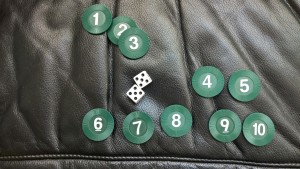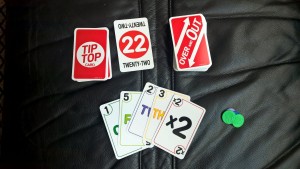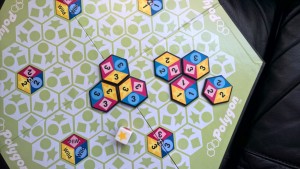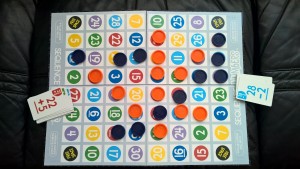A lot of the STEM-related toys and games we review here focus on science and engineering (building). This week we take a look at five entertaining games that emphasize math. They’re all from Jax, Ltd., and you can find out more at jaxgames.com/
The Game of Chips
 Players take turn rolling the dice and removing any combination of chips (numbered 1-10) that match what they rolled. For example, if you roll an 8, you can take out the 8, 7+1, 6+2, 5+3, 5+2+1. 4+3+1. This part of the game is a great way for young players to use and master basic addition facts. But wait—there’s a small element of strategy involved too. If it’s your turn and there aren’t enough chips left on the table to match your dice, you score the total on those chips. Low score wins. For two or more players, ages 7+. Under $8.
Players take turn rolling the dice and removing any combination of chips (numbered 1-10) that match what they rolled. For example, if you roll an 8, you can take out the 8, 7+1, 6+2, 5+3, 5+2+1. 4+3+1. This part of the game is a great way for young players to use and master basic addition facts. But wait—there’s a small element of strategy involved too. If it’s your turn and there aren’t enough chips left on the table to match your dice, you score the total on those chips. Low score wins. For two or more players, ages 7+. Under $8.
Match ‘Em
 Each player gets five cards and the first player lays one down. The next in line plays as many cards as possible to match the value of the first player’s card (similar to the matching combinations in The Game of Chips). If you can’t come up with a match, you draw two from the deck and either make a match or establish a new target. The goal, of course, is to be the first to use all your cards. To win, you’ll need a combination of luck, strategy (to make your opponents draw more cards), and a sense of humor. For 2-4 players, ages 7+. About $4.
Each player gets five cards and the first player lays one down. The next in line plays as many cards as possible to match the value of the first player’s card (similar to the matching combinations in The Game of Chips). If you can’t come up with a match, you draw two from the deck and either make a match or establish a new target. The goal, of course, is to be the first to use all your cards. To win, you’ll need a combination of luck, strategy (to make your opponents draw more cards), and a sense of humor. For 2-4 players, ages 7+. About $4.
Over and Out
 It all starts with a “Tip Top” card. Players draw cards from the deck and play cards from their own hand, keeping track of the total, and hoping not to be the one who goes over the Tip Top limit. It’s not all about addition, though. Special cards require players to subtract, or even change the Tip Top number. A fun, fast-paced way to use basic math facts and, of course, to spend time together. For 2-8 players, ages 7+. About $7.
It all starts with a “Tip Top” card. Players draw cards from the deck and play cards from their own hand, keeping track of the total, and hoping not to be the one who goes over the Tip Top limit. It’s not all about addition, though. Special cards require players to subtract, or even change the Tip Top number. A fun, fast-paced way to use basic math facts and, of course, to spend time together. For 2-8 players, ages 7+. About $7.
Polygon
 The rules of this game are sometimes a challenge to follow, but the game itself is well worth learning. Each of the six-sided pieces has three numbers and three colors and your goal is to lay down your tiles in patterns and combinations that get you the most points. Sounds simple, but this game requires a lot of thinking and strategizing. It’s also a fun way to practice basic addition and multiplication facts. For 2-4 players, ages 7+ (although it’s also a fun game to play by yourself). About $16.
The rules of this game are sometimes a challenge to follow, but the game itself is well worth learning. Each of the six-sided pieces has three numbers and three colors and your goal is to lay down your tiles in patterns and combinations that get you the most points. Sounds simple, but this game requires a lot of thinking and strategizing. It’s also a fun way to practice basic addition and multiplication facts. For 2-4 players, ages 7+ (although it’s also a fun game to play by yourself). About $16.
Sequence Numbers
 If you like the Sequence games, you already have a pretty good idea of how to play Sequence Numbers. But this one’s a little different. In the other Sequence games, you match pictures on cards with pictures on the game board. In Numbers, each card has an addition or subtraction equation and the answers are on the board. Solve the equation and put down your chip. As with other Sequence games, the goal is to get five chips in a row, up, down, or diagonally. To make it a little easier to find your answer on the board—and to help younger players double-check their math—the equations and their correct answer are printed in the same color. This is a really fun game that’ll get you and the kids thinking and laughing together as you brush up on your basic math facts. Ages 7+, 2-6 players. Around $16.50.
If you like the Sequence games, you already have a pretty good idea of how to play Sequence Numbers. But this one’s a little different. In the other Sequence games, you match pictures on cards with pictures on the game board. In Numbers, each card has an addition or subtraction equation and the answers are on the board. Solve the equation and put down your chip. As with other Sequence games, the goal is to get five chips in a row, up, down, or diagonally. To make it a little easier to find your answer on the board—and to help younger players double-check their math—the equations and their correct answer are printed in the same color. This is a really fun game that’ll get you and the kids thinking and laughing together as you brush up on your basic math facts. Ages 7+, 2-6 players. Around $16.50.
